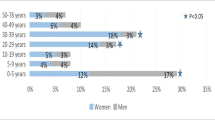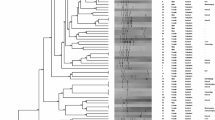Abstract
Uropathogenic Escherichia coli (UPEC) strains are the most common cause of urinary tract infection (UTI) in hospitalized and community patients. The aim was to compare the genetic characteristics of E. coli isolated from inpatients (IPs) and outpatients (OPs) with UTI regarding their phylogenies, virulence traits, and resistance trends. In this cross-sectional study, 130 epidemiologically unrelated E. coli isolates were collected from patients with UTI. Extended-spectrum beta-lactamase (ESBL) production was detected by the combination disk method. UPEC and intestinal pathogenic E. coli (IPEC) virulence genes were detected by polymerase chain reaction. The isolates were analyzed for phylogenetic grouping. A P value of < 0.05 was considered significant. Of the 130 isolates, 62.3% were from OPs and 37.7% from IPs. About 35.8% of the OPs and 49% of the IPs were ESBL positive. Moreover, 56.8% of the OPs and 59.2% of the IPs were positive for UPEC virulence genes. Notably, 50% of the isolates from each group exhibited IPEC virulence properties. The predominant phylogroup was B2 (43.2% in the OPs and 40.8% in the IPs). No significant difference was found between the IP and OP isolates (P > 0.05). Our results may indicate that consideration should also be given to hygienic standards in the community. The marked genetic plasticity of E. coli has allowed the emergence of strains showing arrays of genes from different pathotypes. Characterization of E. coli isolates in different areas may guide the selection of effective infection control strategies.


Similar content being viewed by others
Data availability
All data generated or analyzed during this study are included in this article.
References
Abe CM, Salvador FA, Falsetti IN, Vieira MA, Blanco J, Blanco JE et al (2008) Uropathogenic Eschersichia coli (UPEC) strains may carry virulence properties of diarrhoeagenic E. coli. FEMS Immunol Med Microbiol 52(3):397–406
Akhavizadegan H, Hosamirudsari H, Pirroti H, Akbarpour S (2021) Antibiotic resistance: a comparison between inpatient and outpatient uropathogens. East Mediterr Health J 27(2):124–130
Aranda K, Fagundes-Neto U, Scaletsky IC (2004) Evaluation of multiplex PCRs for diagnosis of infection with diarrheagenic Escherichia coli and Shigella spp. J Clin Microbiol 42(12):5849–5853
Bakhtiari S, Mahmoudi H, Seftjani SK, Amirzargar MA, Ghiasvand S, Ghaffari ME et al (2020) Antibiotic resistance pattern and phylogenetic groups of the uropathogenic Escherichia coli isolates from urinary tract infections in Hamedan, west of Iran. Iranian J Microbiol 12(5):388
Beceiro A, Tomás M, Bou G (2013) Antimicrobial resistance and virulence: a successful or deleterious association in the bacterial world? Clin Microbiol Rev 26(2):185–230
Bien J, Sokolova O, Bozko P (2012) Role of uropathogenic Escherichia coli virulence factors in development of urinary tract infection and kidney damage. Int J Nephrol 2012:681473
Bou G, Cervero G, Dominguez M, Quereda C, Martinez-Beltran J (2000) PCR-based DNA fingerprinting (REP-PCR, AP-PCR) and pulsed-field gel electrophoresis characterization of a nosocomial outbreak caused by imipenem-and meropenem-resistant Acinetobacter baumannii. Clin Microbiol Infect 6(12):635–643
Clermont O, Christenson JK, Denamur E, Gordon DM (2013) The Clermont Escherichia coli coli phylo-typing method revisited: improvement of specificity and detection of new phylo-groups. Environ Microbiol Reports 5(1):58–65
CLSI (2020) Performance standards for antimicrobial susceptibility testing. 30th ed. CLSI supplement M100. Clinical and Laboratory Standards Institute, Wayne, PA
Cristea VC, Gheorghe I, Czobor Barbu I, Popa LI, Ispas B, Grigore GA et al (2019) Snapshot of phylogenetic groups, virulence, and resistance markers in Escherichia coli uropathogenic strains isolated from outpatients with urinary tract infections in Bucharest, Romania. BioMed Res Int 2019:5712371
Fernández A, Pérez A, Ayala JA, Mallo S, Rumbo-Feal S, Tomás M et al (2012) Expression of OXA-type and SFO-1 β-lactamases induces changes in peptidoglycan composition and affects bacterial fitness. Antimicrob Agents Chemother 56(4):1877–1884
Gajdács M, Ábrók M, Lázár A, Burián K (2019) Comparative epidemiology and resistance trends of common urinary pathogens in a tertiary-care hospital: a 10-year surveillance study. Medicina 55(7):356
Grabe M, Bjerklund-Johansen T, Botto H, Çek M, Naber K, Tenke P et al (2015) Guidelines on urological infections. European Association of Urology 182:237–257
Iranpour D, Hassanpour M, Ansari H, Tajbakhsh S, Khamisipour G, Najafi A (2015) Phylogenetic groups of Escherichia coli strains from patients with urinary tract infection in Iran based on the new Clermont phylotyping method. BioMed Res Int 2015:846219
Lara F, Nery DR, De Oliveira PM, Araujo ML, Carvalho FR, Messias-Silva LC et al (2017) Virulence markers and phylogenetic analysis of Escherichia coli strains with hybrid EAEC/UPEC genotypes recovered from sporadic cases of extraintestinal infections. Front Microbiol 8:146
Lavigne J-P, Bruyère F, Bernard L, Combescure C, Ronco E, Lanotte P et al (2016) Resistance and virulence potential of uropathogenic Escherichia coli strains isolated from patients hospitalized in urology departments: a French prospective multicentre study. J Med Microbiol 65(6):530–537
Le Bouguenec C, Archambaud M, Labigne A (1992) Rapid and specific detection of the pap, afa, and sfa adhesin-encoding operons in uropathogenic Escherichia coli strains by polymerase chain reaction. J Clin Microbiol 30(5):1189–1193
Lee J, Subhadra B, Son YJ, Kim D, Park H, Kim J et al (2016) Phylogenetic group distributions, virulence factors and antimicrobial resistance properties of uropathogenic Escherichia coli strains isolated from patients with urinary tract infections in South Korea. Lett Appl Microbiol 62(1):84–90
Matta R, Hallit S, Hallit R, Bawab W, Rogues A-M, Salameh P (2018) Epidemiology and microbiological profile comparison between community and hospital acquired infections: a multicenter retrospective study in Lebanon. J Infect Public Health 11(3):405–411
Muriuki CW, Ogonda LA, Kyanya C, Matano D, Masakhwe C, Odoyo E et al (2022) Phenotypic and genotypic characteristics of uropathogenic Escherichia coli isolates from Kenya. Microbial Drug Resistance 28(1):31–38
Nabti LZ, Sahli F, Radji N, Mezaghcha W, Semara L, Aberkane S et al (2019) High prevalence of multidrug-resistant Escherichia coli in urine samples from inpatients and outpatients at a tertiary care hospital in Setif. Algeria Microbial Drug Resist 25(3):386–393
Nguyen TV, Le Van P, Le Huy C, Gia KN, Weintraub A (2005) Detection and characterization of diarrheagenic Escherichia coli from young children in Hanoi. Vietnam J Clin Microbiol 43(2):755–760
Nishi J, Sheikh J, Mizuguchi K, Luisi B, Burland V, Boutin A et al (2003) The export of coat protein from enteroaggregative Escherichia coli by a specific ATP-binding cassette transporter system. J Biol Chem 278(46):45680–45689
Norouzian H, Katouli M, Shahrokhi N, Sabeti S, Pooya M, Bouzari S (2019) The relationship between phylogenetic groups and antibiotic susceptibility patterns of Escherichia coli strains isolated from feces and urine of patients with acute or recurrent urinary tract infection. Iranian J Microbiol 11(6):478
Olesen B, Kolmos H, Ørskov F, Ørskov I (1995) A comparative study of nosocomial and community-acquired strains of Escherichia coli causing bacteraemia in a Danish University Hospital. J Hosp Infect 31(4):295–304
Olesen B, Scheutz F, Andersen RL, Menard M, Boisen N, Johnston B et al (2012) Enteroaggregative Escherichia coli O78: H10, the cause of an outbreak of urinary tract infection. J Clin Microbiol 50(11):3703–3711
Ouedraogo A-S, Sanou M, Kissou A, Sanou S, Solaré H, Kaboré F et al (2016) High prevalence of extended-spectrum ß-lactamase producing enterobacteriaceae among clinical isolates in Burkina Faso. BMC Infect Dis 16(1):1–9
Paniagua-Contreras GL, Monroy-Pérez E, Bautista A, Reyes R, Vicente A, Vaca-Paniagua F et al (2018) Multiple antibiotic resistances and virulence markers of uropathogenic Escherichia coli from Mexico. Pathogens and Global Health 112(8):415–420
Piatti G, Mannini A, Balistreri M, Schito AM (2008) Virulence factors in urinary Escherichia coli strains: phylogenetic background and quinolone and fluoroquinolone resistance. J Clin Microbiol 46(2):480–487
Regua-Mangia AH, Irino K, da Silva PR, Pimentel Bezerra RM, Santos Périssé AR, Teixeira LM (2010) Molecular characterization of uropathogenic and diarrheagenic Escherichia coli pathotypes. J Basic Microbiol 50(S1):S107–S115
Tabasi M, Karam MRA, Habibi M, Mostafavi E, Bouzari S (2016) Genotypic characterization of virulence factors in Escherichia coli isolated from patients with acute cystitis, pyelonephritis and asymptomatic bacteriuria. J Clin Diagnostic Res 10(12):DC01–DC07
Tille P (2015) Bailey & Scott's diagnostic microbiology: Elsevier Health Sciences
Toval F, Köhler C-D, Vogel U, Wagenlehner F, Mellmann A, Fruth A et al (2014a) Characterization of Escherichia coli isolates from hospital inpatients or outpatients with urinary tract infection. J Clin Microbiol 52(2):407–418
Toval F, Schiller R, Meisen I, Putze J, Kouzel IU, Zhang W et al (2014b) Characterization of urinary tract infection-associated Shiga toxin-producing Escherichia coli. Infect Immun 82(11):4631–4642
Yamamoto S, Terai A, Yuri K, Kurazono H, Takeda Y, Yoshida O (1995) Detection of urovirulence factors in Escherichia coli by multiplex polymerase chain reaction. FEMS Immunol Med Microbiol 12(2):85–90
Funding
This study was supported by a grant [IR.MUK.REC.1398.244] from the Faculty of Medicine, Kurdistan University of Medical Sciences, Sanandaj, Iran.
Author information
Authors and Affiliations
Corresponding author
Ethics declarations
Ethics approval and consent to participate
IR.MUK.REC.1398.244, Research Ethics Committee (REC), Faculty of Medicine, Kurdistan University of Medical Sciences.
Competing interests
The authors declare no competing interests.
Additional information
Communicated by Agnieszka Szalewska-Palasz.
Publisher's note
Springer Nature remains neutral with regard to jurisdictional claims in published maps and institutional affiliations.
Rights and permissions
Springer Nature or its licensor holds exclusive rights to this article under a publishing agreement with the author(s) or other rightsholder(s); author self-archiving of the accepted manuscript version of this article is solely governed by the terms of such publishing agreement and applicable law.
About this article
Cite this article
Derakhshan, S., Saedi, S., Ahmadi, A. et al. Virulence genes, phylogenetic analysis, and antimicrobial resistance of Escherichia coli isolated from urinary tract infection in hospitalized patients and outpatients. J Appl Genetics 63, 805–813 (2022). https://doi.org/10.1007/s13353-022-00718-8
Received:
Revised:
Accepted:
Published:
Issue Date:
DOI: https://doi.org/10.1007/s13353-022-00718-8




